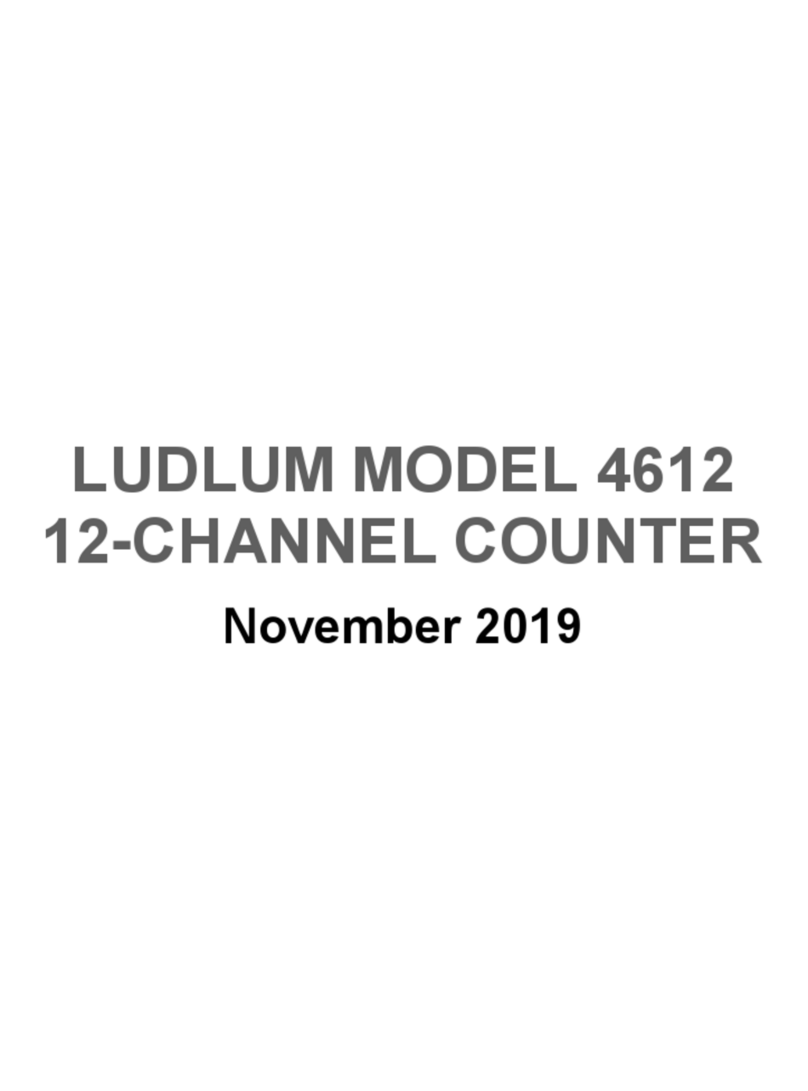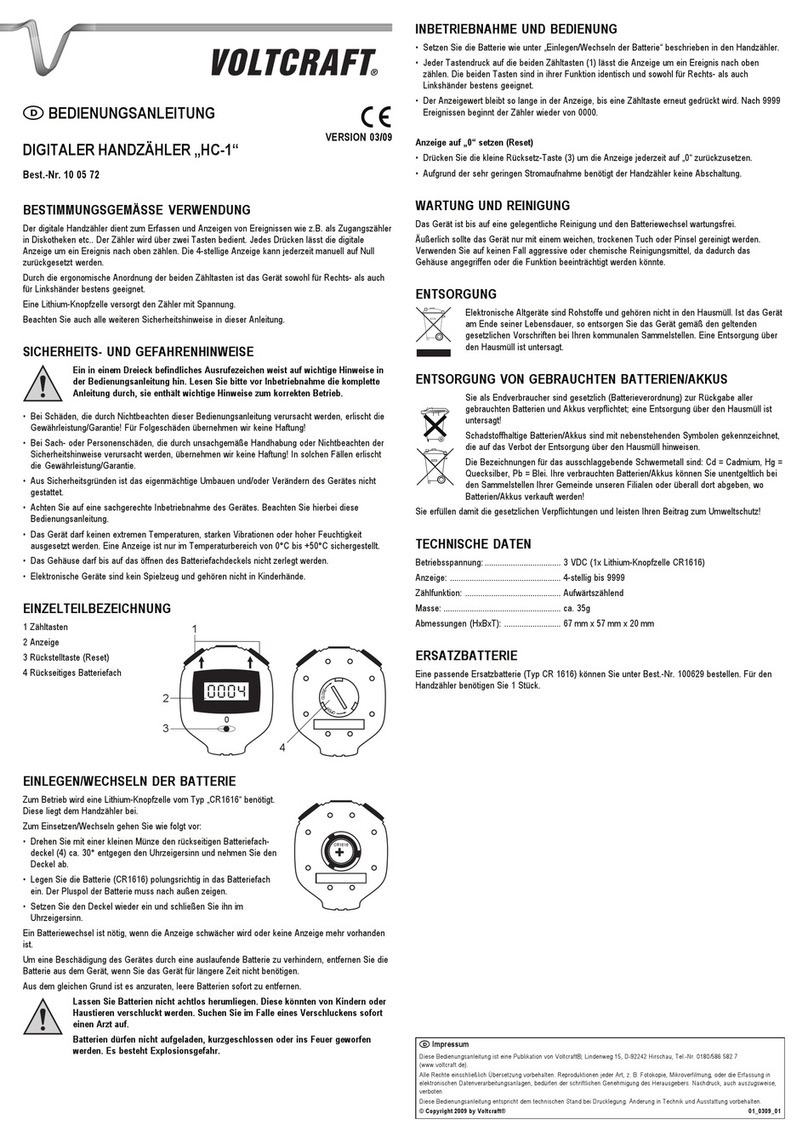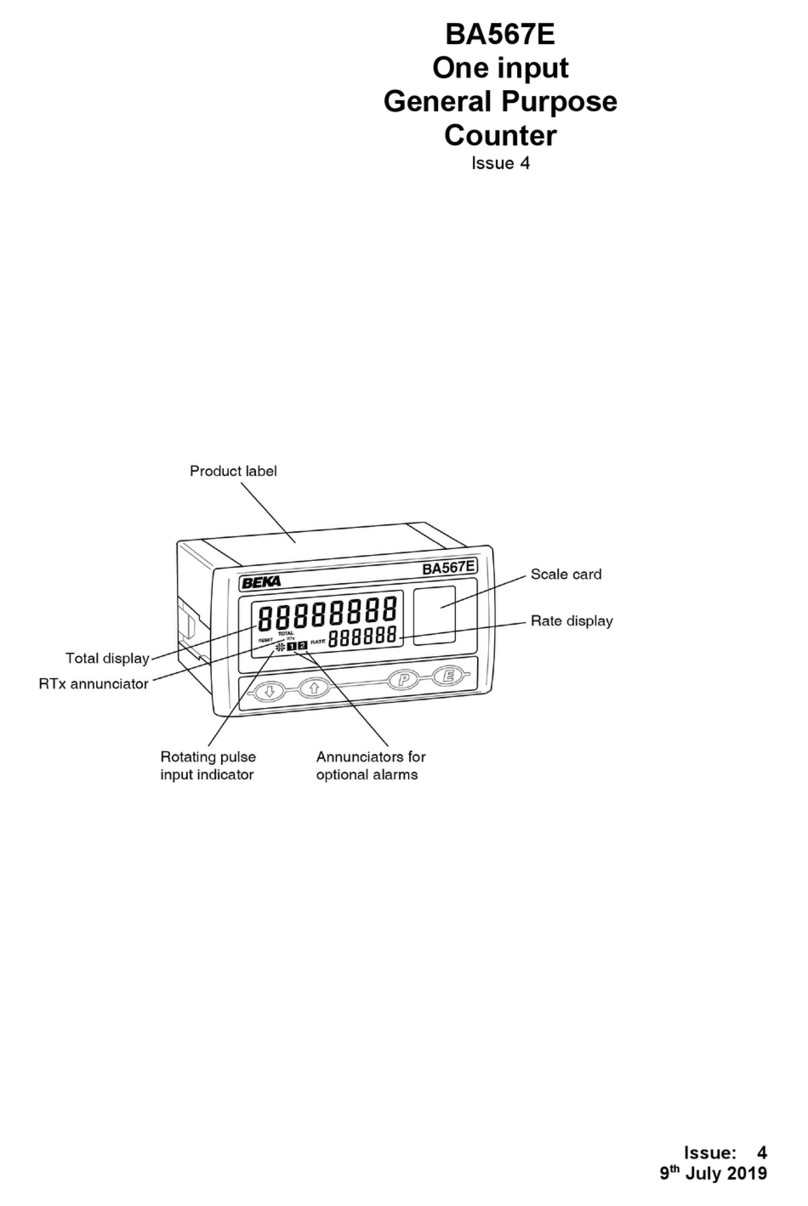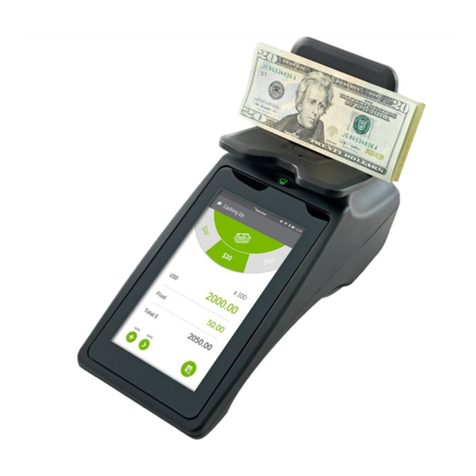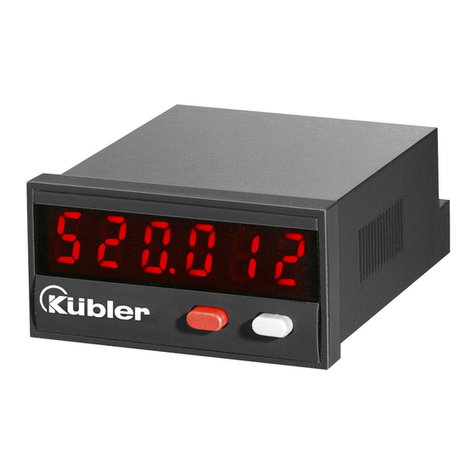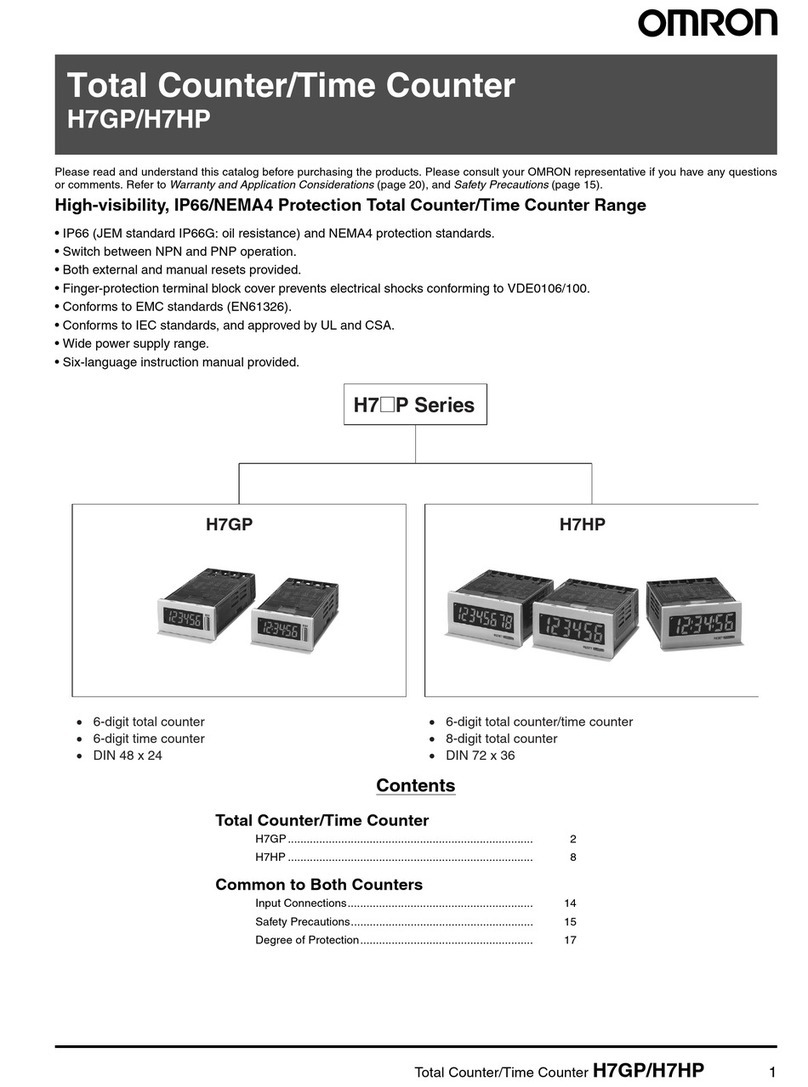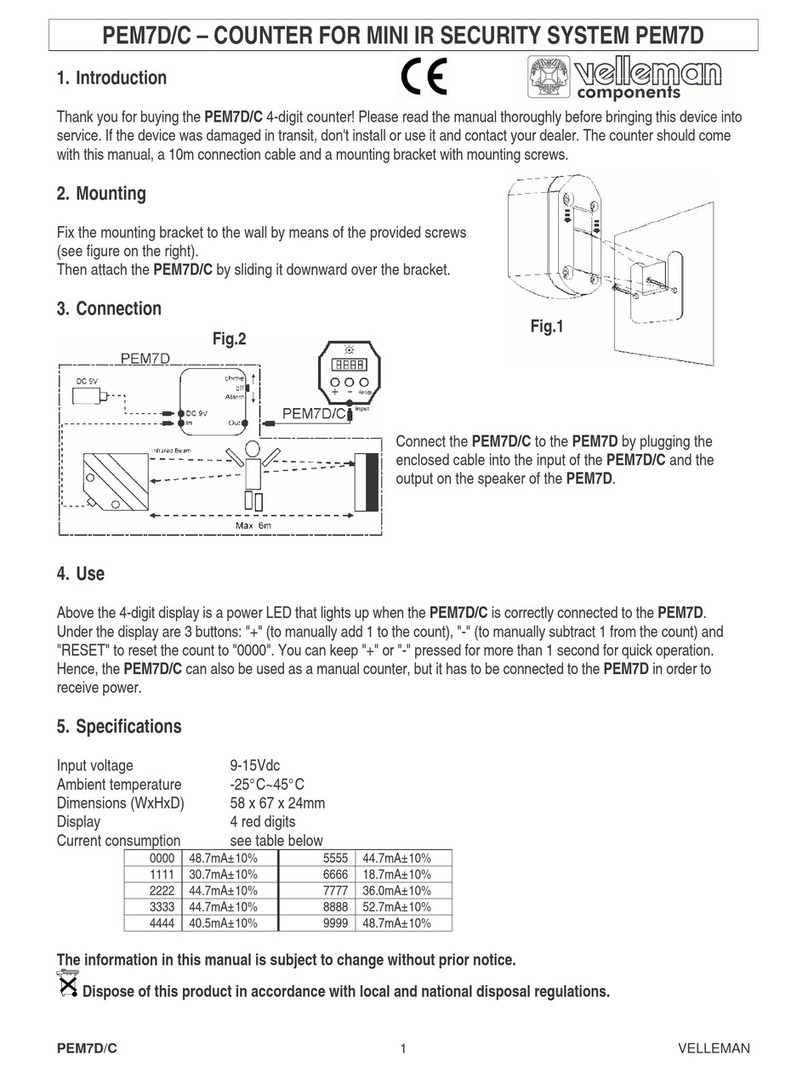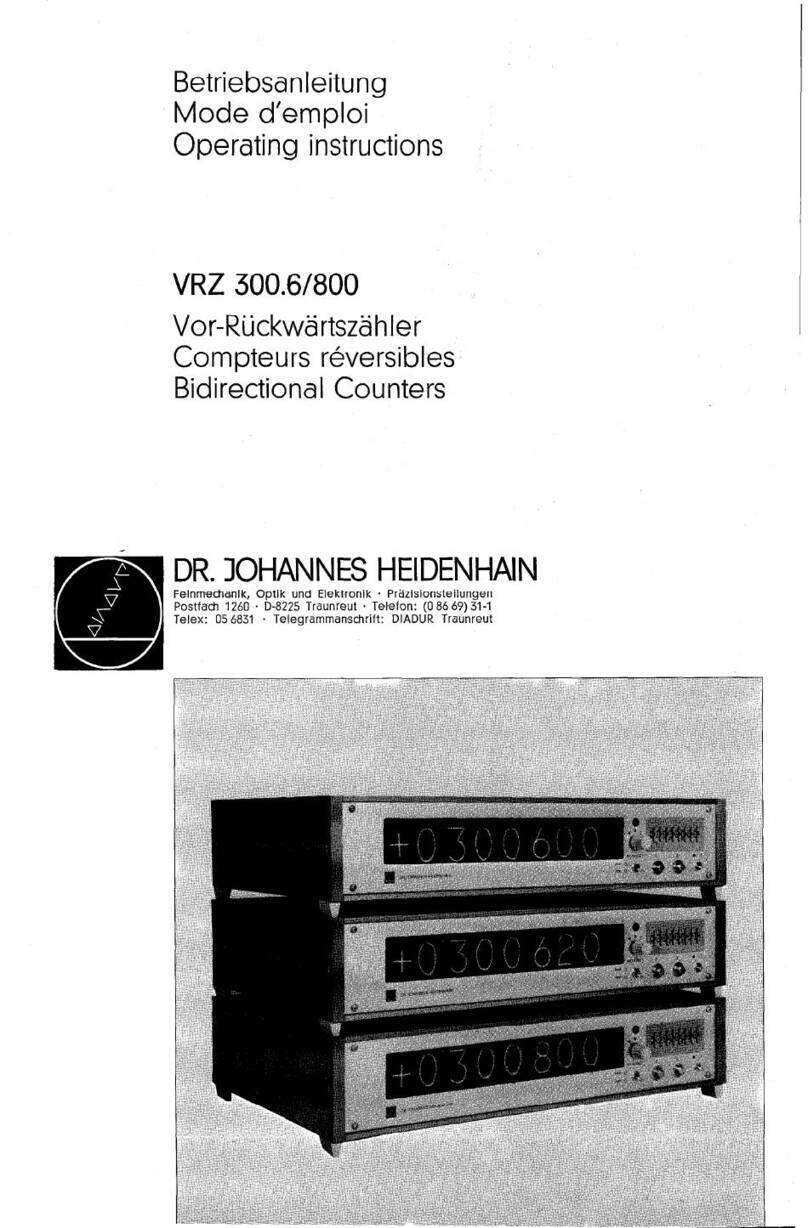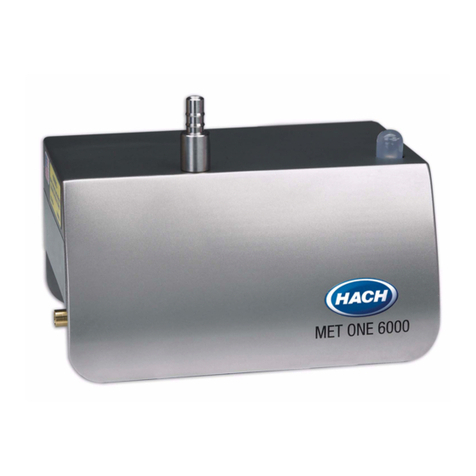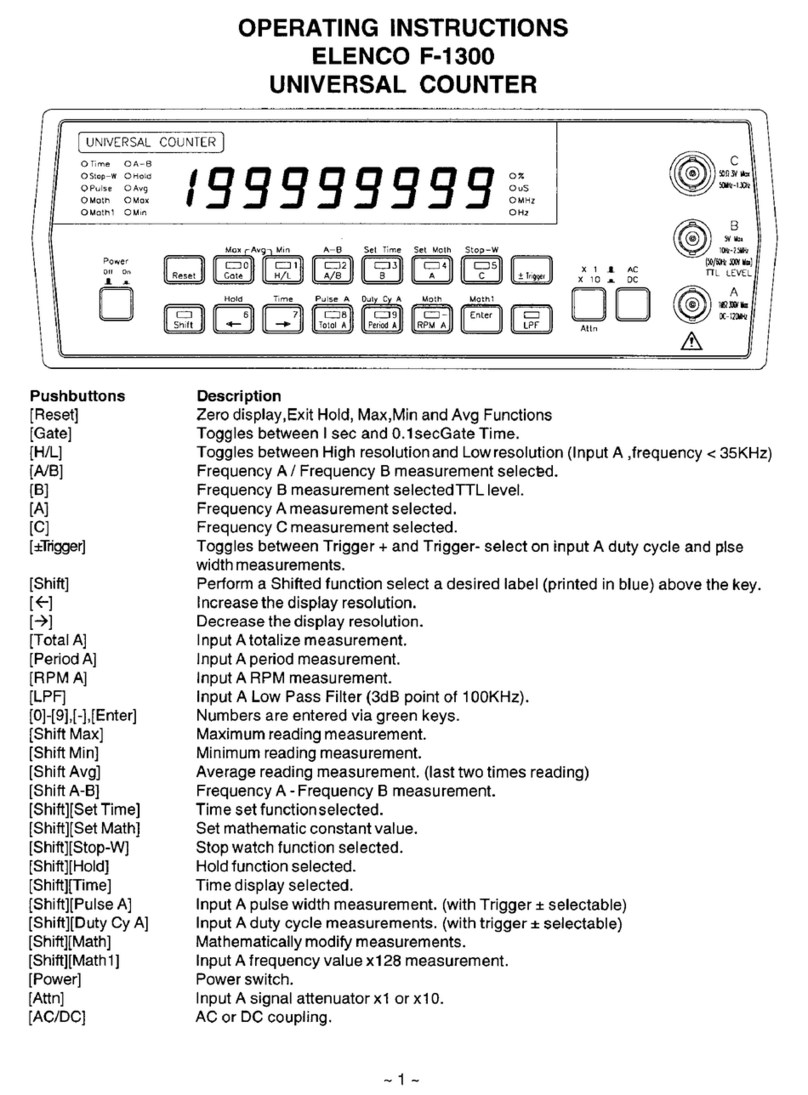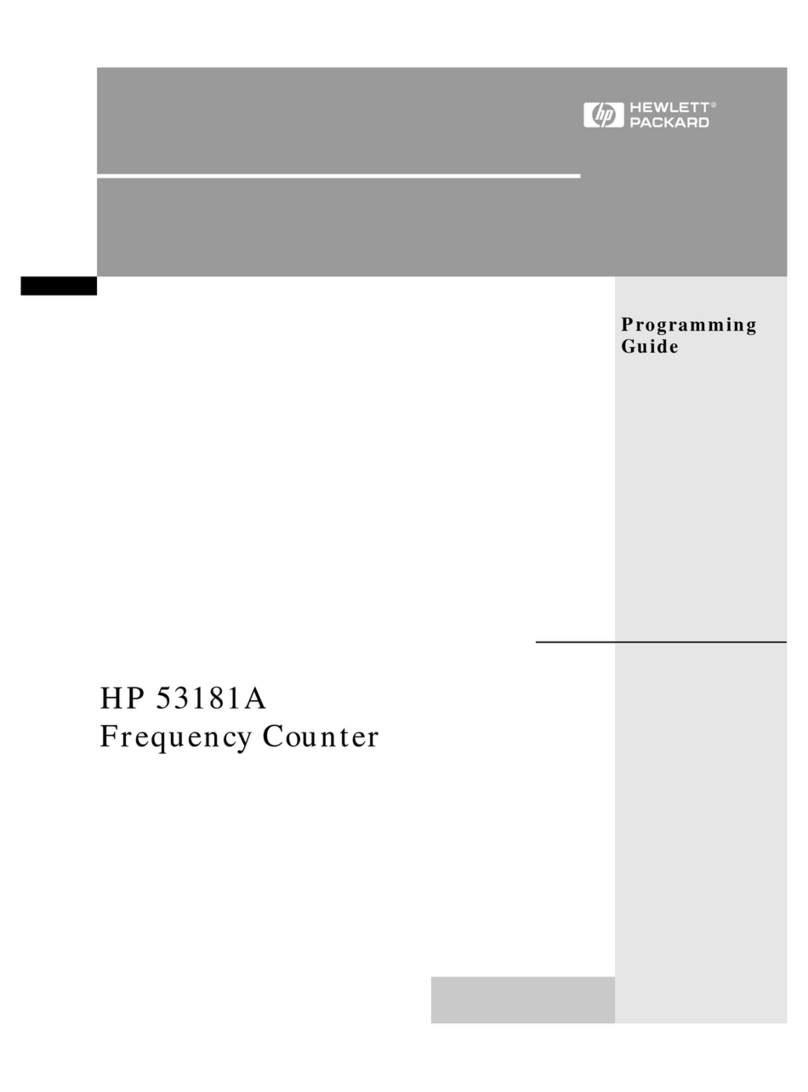EG&G ORTEC 994 User manual

r
A-
/
n
,5'^^
Model
994
Dual
Counter
and
Timer
Operating
Manual
.4
J

Model
994
Dual
Counter
and
Timer
Operating
Manual
This
manual
applies
to
instruments
marked
"Rev
00"
on
rear
panel
Printed
in
U.S.A.
EG&G
ORTEG
Part
No.
736780
<»,
3802
0287

standard
Warranty
for
EG&G
ORTEC
Nuclear
Electronic
Instruments
EG&G
ORTEC
warrants
that
the
items
will
be
delivered
free
from
defects
in
material
or
workmanship.
EG&G
ORTEC
makes
no
other
warranties,
express
or
implied,
and
specifically
NO
WARRANTY
OF
MERCHANTABILITY
OR
FITNESS
FOR
A
PARTICULAR
PURPOSE.
EG&G
ORTEC's
exclusive
liability
is
limited
to
repairing
or
replacing
at
EG&G
ORTEC's
option,
items
found
by
EG&G
ORTEC
to
be
defective
in
workmanship
or
materials
within
two
years
from
the
date
of
delivery.
EG&G
ORTEC's
liability
on
any
claim
of
any
kind,
including
negligence,
loss
or
damages
arising
out
of,
connected
with,
or
from
the
performance
or
breach
thereof,
or
from
the
manufacture,
sale,
delivery,
resale,
repair,
or
use
of
any
item
or
services
covered
by
this
agree
ment
or
purchase
order,
shall
in
no
case
exceed
the
price
allocable
to
the
item
or
service
furnished
or
any
part
thereof
that
gives
rise
to
the
claim.
In
the
event
EG&G
ORTEC
fails
to
manufacture
or
deliver
items
called
for
in
this
agreement
or
pur
chase
order,
EG&G
ORTEC's
exclusive
liability
and
buyer's
exclusive
remedy
shall
be
release
of
the
buyer
from
the
obliga
tion
to
pay
the
purchase
price.
In
no
event
shall
EG&G
ORTEC
be
liable
for
special
or
consequential
damages.
Quality
Control
Before
being
approved
for
shipment,
each
EG&G
ORTEO
nuclear
electronic
instrument
must
pass
a
stringent
set
of
quality
control
tests
designed
to
expose
any
flaws
in
materials
or
workmanship.
Permanent
records
of
these
tests
are
maintained
for
use
in
warrany
repair
and
as
a
source
of
statistical
information
for
design
improvements.
Repair
Service
If
it
becomes
necessary
to
return
this
instrument
for
repair,
it
is
essential
that
Customer
Services
be
contacted
in
advance
of
its
return
so
that
a
Return
Authorization
Number
can
be
assigned
to
the
unit.
Also,
EG&G
ORTEC
must
be
informed,
either
in
writing,
by
telephone
[(615)
482-4411
]
or
by
telex
(55-7450)
of
the
nature
of
the
fault
of
the
instrument
being
re
turned
and
of
the
model,
serial,
and
revision
("Rev"
on
rear
panel)
numbers.
Failure
to
do
so
may
cause
unnecessary
delays
in
getting
the
unit
repaired.
The
EG&G
ORTEC
standard
procedure
requires
that
instruments
returned
for
repair
pass
the
same
quality
control
tests
that
are
used
for
new-production
instruments.
Instruments
that
are
returned
should
be
packed
so
that
they
will
withstand
normal
transit
handling
and
must
be
shipped
PREPAID
via
Air
Parcel
Post
or
United
Parcel
Service
to
the
nearest
EG&G
ORTEC
repair
center.
(In
the
case
where
the
instrument
did
not
function
upon
pur
chase;
EG&G
ORTEC
will
pay
shipment
costs
both
ways.)
The
address
label
and
the
package
should
include
the
Return
Authorization
Number
assigned.
Instruments
being
returned
that
are
damaged
in
transit
due
to
inadequate
packing
will
be
repaired
at
the
sender's
expense,
and
it
will
be
the
sender's
responsibility
to
make
claim
with
the
shipper.
Instruments
not
in
warranty
will
be
repaired
at
the
standard
charge
unless
they
have
been
grossly
misused
or
mishandled,
in
which
case
the
user
will
be
notified
prior
to
the
repair
being
done.
A
quotation
will
be
sent
with
the
notification.
Damage
in
Transit
Shipments
should
be
examined
immediately
upon
receipt
for
evidence
of
external
or
concealed
damage.
The
carrier
making
delivery
should
be
notified
immediately
of
any
such
damage,
since
the
carrier
is
normally
liable
for
damage
in
shipment.
Packing
materials,
waybills,
and
other
such
documentation
should
be
preserved
in
order
to
establish
claims.
After
such
notification
to
the
carrier,
please
notify
EG&G
ORTEC
of
the
circumstances
so
that
assistance
can
be
provided
in
making
damage
claims
and
in
providing
replacement
equipment
if
necessary.

iii
CONTENTS
Page
WARRANTY
ii
PHOTOGRAPHS
iv
1.
DESCRIPTION
1
2.
SPECIFICATIONS
3
2.1.
Performance
3
2.2.
Indicators
3
2.3.
Controls
3
2.4.
Inputs
4
2.5.
Outputs
4
2.6.
Interfaces
4
2.7.
Electrical
and
Mechanical
5
2.8.
Ordering
Information
5
3.
INSTALLATION
6
3.1.
Input
Polarity
Selection
6
3.2.
Counter
Input
Select
Jumpers
6
3.3.
General
6
3.4.
Connection
to
Power
6
3.5.
Signal
Connections
6
3.6.
Output
Connections
6
3.7.
Preset
Time
Operation
7
3.8.
Preset
Count
Operation
".
8
3.9.
Live-time
Measurements
8
4.
OPTIONS
FOR
THE
MODEL
994
9
4.1.
RS-232-C
Interface
9
4.2.
IEEE-488
(GPIB)
Interface
11
4.3.
Print
Loop
Interface
12
4.4.
Internal
-t-6
V
Supply
Option
14
5.
PROGRAMMING
THE
994
15
5.1.
RS-232-C
Interface
15
5.2.
Interfacing
to
the
IEEE-488
BUS
17
APPENDIX
A:
ASCII
COMMANDS
TO
THE
MODULE
A1
A.I.
Command
Words
A1
A.2.
Data
Values
A1
A.3.
Checksums
A1
A.4.
Response
from
the
Module
A1
A.5.
Time
Units
Used
in
Commands
A1
A.6.
Catalog
of
Commands
for
the
994
A1
APPENDIX
B:
RESPONSE
RECORDS
FROM
THE
994
MODULE
B1
B.I.
Delimiting
Characters
B1
B.2.
Percent
Response
Records
.
.
B1
B.3.
Dollar
Response
Records
B1
APPENDIX
C:
OPTIONAL
PARTS
LIST
C1
0.1.
Cables
and
Connectors
C1
C.2.
Ordering
Information
C1
Schematics
726970 723800
726960
729120
729140
ILLUSTRATIONS
Fig.
1.
Selecting
Counter
Source
and
Setting
Input
Polarity
7
Fig.
2.
Selecting
Live
Time
or
Normal
Mode
of
Operation
8
Fig.
3.
Changing
Jumpers
on
the
99X-1
RS-232-C
Interface
Board
10
Fig.
4.
Address
Selection
of
Dip
Switch
on
the
99X-2
IEEE-488
Interface
Board
12
Fig.
5.
Selecting
Operating
Modes
on
the
99X-3
Print
Loop
Interface
Board
13

I
rTK^i5-<»rEc
r^

EG&G
ORTEC
MODEL
994
DUAL
COUNTER
AND
TIMER
1.
DESCRIPTION
The
EG&G
ORTEC
Model
994
Dual
Counter
and
Timer
Incorporates
two
8-decade
counters
and
a
blind
preset
timer.
Considerable
functional
flexibility
is
designed
into
the
instrument,
allowing
it
to
be
configured
for
a
variety
of
measurement
tasks.
Typically,
It
can
be
used
as
two
counters
recording
separate
events
under
the
control
of
the
preset
blind
timer.
When
continuous
readout
of
the
time
is
needed.
Counter
A
can
be
diverted
to
count
the
time
while
Counter
B
records
external
events.
This
provides
the
function
of
a
counter
and
a
displayed
preset
timer.
In
some
applications
the
time
taken
to
count
a
preset
number
of
events
must
be
«
measured.
For
this
application
Counter
A,
coupled
with
the
preset
blind
counter,
can
be
used
as
a
preset
counter
while
Counter
B
records
the
time
In
0.01-second
Intervals.
In
measurements
where
it
Is
Important
to
correct
for
the
dead
time
of
the
detector
and
its
associated
electronics,
the
Gate
A
input
can
be
switched
to
also
gate
the
time
clock
On
and
Off
with
a
100-ns
time
resolution.
A
positive
logic
signal
which
defines
the
system
live
time
Is
connected
to
the
Gate
A
input.
This
configuration
provides
a
live-time
clock
(Counter
A)
and
a
counter
(B).
Excellent
flexibility
in
setting
the
preset
value
Is
offered
by
the
MN
X
10''
selection.
The
M
and
N
values
provide
two-digit
precision
while
P
selects
the
decade.
Presets
can
be
chosen
in
the
ranges
of
0.01
to
990,000
seconds,
0.01
to
990,000
minutes,
or
1
to
99,000,000
counts.
The
basic
Model
994
includes
an
8-decade
LED
display
which
offers
Instantaneous
visual
readout
of
the
full
contents
of
Counter
A
or
B,
even
in
a
dimly
lighted
room.
By
adding
field-installable
options,
considerably
enhanced
readout
and
control
capabilities
can
be
incorporated.
The
full
power
of
CCNIM™
(Computer-Controlled
NIM)
can
be
obtained
by
adding
the
IEEE-488
option
or
the
RS-232-C
option.
These
plug-in
boards
yield
computer
control
of
all
functions
normally
selectable
from
the
front
panel,
including
start
and
stop
count,
readout,
reset,
setting
the
preset
value,
selecting
the
displayed
counter,
and
seleoting
the
desired
time
base.
To
eliminate
accidental
operator
interference,
the
computer
can
disable
all
front-panel
controls
In
the
Remote
mode.
Computer
readout
with
either
of
the
two
CCNIM'"
options
Includes
A
and
B
counts,
the
preset
value,
and
which
counter
is
being
displayed.
The
IEEE-488
option
also
reads
the
overflow
status
for
both
counters.
Implementation
of
the
IEEE-488
Interface
In
the
Model
994
Is
compatible
with
the
NIM/GPIB
standard.*
♦"STANDARD
NIM
DIGITAL
BUS
(NIM/GPIB)",
DOE/ER-0173,
U.S.
NIM
committee,
August
1983;
"IEEE
Standard
Digital
Interface
for
Programmable
Instrumentation,"
ANSI/IEEE
Std
488-1978,
The
Institute
of
Electrical
and
Electronics
Engineers,
345
East
47
Street,
New
York,
NY
10017;
and
"Codes
and
Format
Conventions
for
Use
with
ANSI/IEEE
Std
488-1978,"
ANSI/IEEE
Std
728-1982,
The
Institute
of
Electrical
and
Electronics
Engineers,
345
East
47
Street,
New
York,
NY
10017.
For
automated
counting
applications
not
requiring
computer
Interfacing,
the
standard
EG&G
ORTEC
printloopfunctlon
is
available
as
a
field-installable,
plug-in
board.
In
conjunction
with
an
EG&G
ORTEC
Model
111k
Printer,
this
option
offers
automatic
recycling
of
the
counting
and
printing
of
all
eight
digits
of
the
contents
of
Counters
A
and
B
along
with
other
counters
in
the
print
loop.
Instead
of
the
111k,
the
EG&G
ORTEC
Model
879
Buffered
Interface
can
be
used
to
provide
IEEE-488
and
RS-232-C
interfaces
for
all
the
counters
In
the
print
loop.
The
Model
879
has
the
capability,
through
the
print
loop,
to
start
and
stop
counting,
reset,
and
read
the
contents
of
Counters
A
and
B
In
the
Model
994
along
with
the
other
counters
In
the
print
loop.
The
Inputs
to
Counters
A
and
B
are
individually
selectable
as
either
positive
or
negative
sensing
Inputs
by
changing
the
Input
Polarity
Jumpers
on
the
counter
printed
wiring
board
(PWB).
The
negative
Input
mode
is
designed
to
accept
standard
NIM,
fast-negative
logic
pulses
with
a
fixed
threshold
of
—250
mV
on
a
50-Q
Input
impedance.
The
negative
inputs
can
handle
counting
rates
up
to
100
MHz.
The
positive
input
mode
can
accept
counting
rates
up
to
25
MHz
on
a
1000-Q
Input
impedance.
To
enhance
the
flexibility
of
the
positive
input
mode,
precision
discriminators
are
included
on
both
counters.
The
discriminator
thresholds
are
variable
over
the
range
of
-f-100
mV
to
-f-9.5
V
using
front-panel,
25-turn
trirnpots.
The
thresholds
can
be
adjusted
to
suit
the
amplitude
of
a
specific
source
of
logic
pulses
or
used
as
precision
integral
discriminators
on
analog
pulses.
For
the
latter
application,
the
TTL
logic
outputs
of
the
discriminators
are
provided
as
test
points
on
the
front
panel.
These
outputs
can
be
used
to
trigger
an
oscilloscope
while
viewing
the
analog
signal
at
the
counter
input
on
the
oscilloscope.
The
oscilloscope
trace
will
show
the
signals
that
are
being
counted
by
the
Model
994,
thus
permitting
a
very
selective
adjustment
of
the
threshold.
All
the
commonly
used
functions
are
conveniently
accessible
on
the
front
panel.
Manual
control
of
the
Count,
Stop,
and
Reset
functions
is
via
three
push
buttons.
The
Gate
LED
is
illuminated
when
the
Model
994
Is
enabled
to
count.
Selection
of
the
0.01-second,
0.01-
minute,
or
external
time
base
Is
made
by
the
Time
Base
push
button.
In
the
external
mode
the
preset
counter
counts
the
events
at
the
Counter
A
Input.
The
Display
push
button
switches
the
display
to
show
the
contents
of
Counter
A,
or
the
preset
stop
value,
or
the
contents
of
Counter
B.
To
change
the preset
value,
the
Preset
mode
must
first
be
selected
with
the
Display
push
button.
Subsequently,
the
Preset
Select
push
button
is
used
to
choose
M,
N,
or
P
for
adjustment.
Changing
the
value
of
M,
N,
or
P
Is
accomplished
with
the
Preset
Advance
push
button.
The
display
contains
LED
flags
to
indicate
whether
M,
N,
or
P
has
been
selected,
to
warn
when
overflows
have
occurred
in
Counter
A
or
Counter
B,
and
to

advise
when
the
front-panel
controls
are
disabled
by
the
computer
in
the
Remote
mode.
When
the
Model
994
is
used
in
the
automatic
recycle
mode,
the
Dwell
knob
adjusts
the
dwell
time
of
the
display
from
1
to
10
seconds.
The
counting
function
of
the
entire
module
can
be
disabled
by
holding
the
Enable
input
below
-1-1.5
V
using
an
external
signal
source.
This
condition
also
turns
off
the
Gate
LED.
Open
circuit
or
>-t-3
V
at
the
Enable
input
allows
the
instrument
to
count,
if
the
Count
mode
has
been
activated.
The
Interval
output
of
another
EG&G
ORTEC
timer
can
perform
this
function
to
synchronize
the
Model
994
counting
with
the
other
timer.
The
Interval
outputs
on
all
EG&G
ORTEC
timers
provide
nominally
-1-5
V
when
counting
and
<-1-0.5
V
when
counting
is
inhibited.
Independent
gating
of
the
A
and
B
Counter
inputs
can
be
achieved
with
the
Gate
A
and
Gate
B
inputs
on
the
rear
panel.
Interface
connectors
for
the
IEEE-488,
RS-232-C,
and
print
loop
options
are
also
located
on
the
rear
panel.
Each
counter
has
a
rear
panel
output
dedicated
to
signaling
overflows.
Counting
these
overflows
on
another
counter
extends
the
counting
capacity
of
the
Model
994.
The
Model
994
derives
its
power
from
the
±12
V
and
-1-6
V
supplies
in
astandard
NIM
bin
with
powersupply.
Forbins
that
do
not
contain
a
+6
V
supply
an
Internal
-F6
V
Supply
option
is
available.
This
option
is
field-installable
and
derives
its
power
from
the
117
V
ac
lines
in
the
bin.

2.
SPECIFICATIONS
2.1.
PERFORMANCE
COUNT
CAPACITY
8
decades
for
counts
ranging
from
0
to
99,999,999
in
eacft
of
2
counters.
MAXIMUM
COUNTING
RATE
100
MHz
for
negative
inputs,
25
MHz
for
positive
inputs.
TIME
BASE
10-MHz
clock
with
minimum
preset
or
displayed
intervals
of
0.01
seconds
or
0.01
minutes.
Synchronizing
error
is
nominally
100
ns.
Also
accepts
an-
external
input
from
the
Counter
A
input
(In
A)
when
the
Ext
(External)
mode
is
selected.
TIME
BASE
INACCURACY
<±0.0025%
over
the
0
to
50°
0
operating
temperature
range.
PRESET
TIME/COUNTS
The
module
stops
counting
when
the
preset
value
MN
x
lO*"
Is
reached
on
the
blind
preset
register.
M
and
N
are
digits
ranging
from
0
to
9.
P
is
a
digit
ranging
from
0
to
6.
With
the
0.01
second
time
base,
preset
times
from
0.01
to
990,000
seconds
can
be
used.
Preset
times
from
0.01
to
990,000
minutes
are
available
using
theO.01
minute
time
base.
IntheExttime
base
mode
preset
counts
in
the
range
of
1
to
99,000,000
can
be
used.
POSITIVE
INPUT
DISCRIMINATOR
Threshold
variable
from
+100
mV
to
+9.5
V
with
a
25-turn
trimpot.
PULSE
PAIR
RESOLUTION
<40
ns
for
positive
inputs.
<10
ns
for
negative
inputs;
2.2.
INDICATORS
COUNTER
DISPLAY
8-digit,
7-segment
LED
display
with
leading
zero
suppression.
When
displaying
time,
2
digits
to
the
right
of
a
decimal
point
are
included.
OVERFLOW
INDICATORS
LED
indicators
labeled
Ovfl
A
and
Ovfl
B
illuminate
when
the
corresponding
A
or
B
Counter
exceeds
its
capacity
of
8
decades.
The
indicator
remains
on
until
a
reset
is
generated.
M,
N,
AND
P
INDICATORS
3
LED
indicators
aid
in
the
selection
of
the
preset
value.
When
the
Preset
display
function
is
activated
the
Select
push
button
selects
which
of
the
3
LEDs
is
illuminated.
When
one
of
these
LEDs
is
On,
that
digit
of
the
preset
value
can
be
incremented
using
the
Advance
push
button.
DISPLAY
3
LEDs
labeled
A,
B,
and
Preset
indicate
the
information
being
displayed
in
the
counter
display.
Counter
A,
Counter
B,
or
the
Preset
value
may
be
displayed
by
repeatedly
pressing
the
Display
push
button
until
the
desired
LED
is
illuminated.
TIME
BASE
3
LEDs
indicate
the
selected
time
base
source.
By
repeatedly
pressing
the
Time
Base
push
button,
0.01
Sec,
0.01
Min,
orthe
Ext
mode
can
be
chosen.
GATE
A
single
LED
indicates
that
the
entire
instrument
is
enabled
to
count.
Forthe
Gate
LED
to
be
illuminated
the
module
must
be
placed
in
the
Count
mode
(either
manually
or
via
the
interface
option),
the
Enable
input
must
be
above
+3
V,
and
the
preset
stop
condition
must
not
have
been
reached.
REMOTE
A
single
LED
labeled
Rem
indicates
that
the
994
is
under
computer
control,
and
all
front-panel
controls
are
disabled.
This
mode
is
set
by
the
ENABLE
_
REMOTE
command.
2.3.
CONTROLS
DISPLAY
Push
button
selects
the
contents
of
Counter
A
or
B,
or
the
Preset
value
for
presentation
in
the
8-decade
display.
Repeatedly
pushing
the
button
cycles
the
selection
through
the
three
choices
as
Indicated
by
the
A,
Preset,
and
B
LEDs.
SELECT
Push
button
chooses
the
M,
N,
or
P
digit
in
the
display
of
the
preset
value.
Pushing
the
button
advances
the
selection
through
the
three
choices
as
indicated
by
the
illuminated
LED.
The
Select
push
button
operates
only
if
the
Preset
mode
has
been
selected
by
the
Display
push
button.
ADVANCE
Push
button
increments
the
preset
digit
selected
by
the
Select
push
button
once
each
time
the
Advance
button
is
depressed.
The
M
and
N
digit
ranges
are
both
0
to
9.
The
P
digit
range
is
from
0
to
6.
The
Advance
push
button
operates
only
if
the
Preset
mode
has
been
selected
by
the
Display
push
button.
TIME
BASE
Each
push
on
this
button
advances
the
selection
one
step
through
the
three
time
base
choices
of
0.01
Sec,
0.01
Min,
and
Ext
to
determine
the
time
base
source
for
the
preset
register.
STOP
This
push
button
stops
ali
sections
of
the
instrument
from
counting.
RESET
Depressing
this
button
resets
both
counters
to
zero
counts
and
turns
off
both
overflow
indicators.
It
also
clears
any
counts
accumulated
in
the
blind
preset
counter,
but
does
not
change
the
selected
preset
value.
When
power
is
turned
on
to
the
module
a
Reset
is
automatically
generated.
COUNT
Pushing
this
button
enabies
the
counting
condition
for
the
entire
instrument
providing
the
Enable
input
is
not
held
below
+1.5
V
and
the
preset
value
has
not
been
reached.
THRESH
ADJUST
(A
and
B)
Front-panel
mounted,
25-turn
trimpots
to
adjustthe
positive
inputthresholdsfor
Counters
A
and
B.
The
range
is
from
+100
mV
to
+9.5
V.
Adjacent
test
points
provide
the
TTL
logic
signal
outputs
from
the
discriminators
to
facilitate
adjustment
using
an
oscilloscope.
DWELL
A
one-turn
potentiometer
on
the
front
panel
with
an
On/Off
switch
at
the
fully
counterclockwise
position.
Adjusts
the
display
dwell
time
over
the
nominal
range
of
1
to
10
seconds.
When
the
instrument
is
in
the

Recycle
mode,
dwell
time
occurs
afterthe
preset
value
has
been
reached.
Turning
the
switch
Off
at
the
fully
counter
clockwise
position
selects
the
Single
Cycle
mode.
If
the
print
loop
option
is
used,
the
Dwell
control
is
disabled
when
the
print
loop
controller
is
active
and
controlling
the
dwell
time.
INPUT
POLARITY
JUMPERS
Two
jumpers
located
on
the
printed
wiring
board
(PWB)
separately
select
the
desired
input
polarities
for
inputs
In
A
and
In
B.
P
=
positive,
N
=
negative.
A
COUNTER/TIMER
JUMPER
Two-position
jumper
located
on
the
PWB.
In
the
Counter
position,
Counter
A
always
counts
and
displays
the
events
connected
to
In
A.
When
set
to
the
Timer
position.
Counter
A
counts
and
displays
the
time
if
either
the
0.01
Sec
or
the
0.01
Mintime
base
is
selected.
If
the
Ext
time
base
is
selected.
Counter
A
will
count
and
display
the
events
from
In
A.
B
COUNTER/TIMER
JUMPER
Two-position
jumper
located
on
the
PWB.
In
the
Counter
position.
Counter
B
always
counts
and
displays
the
events
from
In
B.
In
the
Timer
position
with
the
Ext
time
base
selected.
Counter
B
counts
and
displays
the
time
in
0.01
second
intervals.
With
either
a
0.01
second
or
0.01
minute
time
base
selected.
Counter
B
counts
and
displays
the
events
from
In
B.
GATE
A
(LIVE
TIME/NORMAL)
JUMPER
Two-position
jumper
mounted
on
the
PWB.
In
the
Normal
position,
the
signals
from
the
rear
panel
Gate
A
connector
gate
the
events
from
the
In
A
connector.
In
the
Live
Time
position,
the
signals
from
the
Gate
A
connector
gate
the
10-MHz
clock
to
form
a
live-time
clock.
1
CYCLE/RECYCLE
Selection
of
either
the
1
Cycle
or
the
Recycle
mode
can
be
made
via
an
8-pin
dip
switch
on
the
IEEE-488
and
the
RS-232-C
interface
boards.
The
Recycle
mode
can
be
used
when
the
computer
is
able
to
respond
with
a
data
transfer
when
the
994
reaches
the
preset
value.
Upon
reaching
preset,
the
994
latches
its
data
into
a
buffer,
resets
the
counters,
and
starts
the
next
counting
interval.
This
process
takes
—50
/js.
The
computer
reads
the
data
in
the
buffer
before
the
next
counting
interval
ends.
In
the
1
Cycle
mode,
the
994
simply
stops
counting
and
waits
for
further
commands
when
the
preset
value
is
reached.
2.4.
INPUTS
IN
A
Use
of
this
input
is
affected
by
the
A
Counter/Timer
Jumper.
Positive
Input
Front-panel
BNC
connectorfor
Counter
A
accepts
positive
unipolar
signals;
minimum
width
above
threshold,
20
ns
at
a
50%
duty
cycle.
The
threshold
is
adjustable
from
4-100
mV
to
-t-9.5
V
via
a
front-panel,
25-
turn
trimpot.
Zm
=
1000
Q
to
ground;
dc
coupled.
Negative
Input
Changing
the
Input
Polarity
Jumper
position
on
the
counter
board
permits
selection
of
the
fast-negative
logic
input
which
is
designed
to
accept—600
to
—1800
mV
pulses
with
a
fixed
discriminator
threshold
of
-250
mV.
Zin
=
50
Q;
dc
coupled.
Minimum
pulse
width
above
threshold
is
4
ns.
IN
B
Identical
to
In
A
except
that
it
feeds
Counter
B.
Use
of
this
input
is
affected
by
the
B
Counter/Timer
Jumper.
ENABLE
Front-panel
BNC
input
connector
accepts
NIM
standard,
slow-positive
logic
pulses
to
control
the
counting
condition
of
the
entire
module.
A
level
of
>-F3
V
or
open
circuit
allows
counting
provided
the
instrument
is
in
the
Count
mode
and
has
not
reached
the
preset
value;
<4-1.5
V
inhibits
counting.
The
driving
source
must
be
capable
of
sinking
5
mA
of
positive
current
during
inhibit;
input
protected
to
4-25
V.
GATE
A
Rear-panel
BNC
input
is
identical
to
the
Gate
B
input
with
the
following
exception.
With
the
Gate
A
jumper
on
the
PWB
set
to
the
Normal
position,
the
Gate
A
input
controls
counting
of
the
In
A
events
in
Counter
A.
By
moving
the
PWB
Gate
A
jumper
to
the
Live
Time
position,
the
Gate
A
input
also
controls
the
10-MHz
clock
to
form
a
live-time
clock
with
a
100
ns
resolution.
A
level
>4-3
V
or
an
open
circuit
allows
counting
of
the
clock.
A
level
<4-1.5
V
is
used
to
inhibit
counting
of
the
clock
during
dead-time
intervals.
GATE
B
Rear-panel
BNC
connector
accepts
NIM
standard,
slow-positive
logic
signais
to
control
the
counting
in
Counter
B.
A
level
>4-3
V
or
open
circuit
allows
counting;
<4-1.5
V
inhibits
counting;
input
protected
to
4-25
V.
The
driving
source
must
be
capable
of
sinking
5
mA
of
positive
current
during
inhibit.
2.5.
OUTPUTS
INTERVAL
Front-panel
output
BNC
connector
furnishes
a
positive
level
during
the
counting
interval.
The
level
is
nominally
4-5
V
when
counting
is
enabled
and
<4-0.5
V
when
counting
is
disabled.
Zo
~
30
C.
OVFL
A
Rear-panel
output
BNC
connector
provides
a
NIM
standard,
slow-positive
logic
signal
each
time
Counter
A
overflows
its
8-decade
capacity.
The
signal
has
a
nominal
amplitude
of
4-5
V;
width
—20
fjs.
OVFL
B
Rear-panel
output
identical
to
Cvf
IA
except
that
it
monitors
overflows
fromCounter
B.
2.6.
INTERFACES
IEEE-488
When
the
IEEE-488
option
board
is
plugged
in
it
furnishes
a
rear-panel,
standard,
IEEE-488
bus
connector.
This
24-pin,
AMP^"CHAMP™
female
connector
allows
the
Model
994
to
be
controlled
from
a
computer
via
the
IEEE-488
bus.
The
field-installable
option
provides
computer
control
of
the
following
functions;
Count,
Stop,
Reset,
Remote,
setting
the
preset
value,
selecting
the
displayed
counter,
and
selecting
the
desired
time
base.
In
the
Remote
mode
the
computer
can
disable
all
front-panel
controls.
Computer
readout
includes:
A
and
B
counts,
the
preset
value,
which
counter
is
being
displayed,
and
the
overflow
status
for
both
counters.
'"Trademark
of
AMP
Inc.

SERIAL
When
the
RS-232-C
option
board
is
plugged
in
it
furnishes
a
rear-panel,
25-pin,
maie,
D
connector
containing
al
l
signals
for
standard
RS-232-C
communications.
It
also
contains
connections
for
20-mA
current
loop
communications.
The
field-instailable
RS-
232-C
option
provides
computer
control
of
the
following
functions;
Count,
Stop,
Reset,
Remote,
setting
the
preset
value,
selecting
the
displayed
counter,
and
selecting
the
desired
time
base.
In
the
Remote
mode
the
computer
can
disable
all
front-panel
controls.
Computer
readout
includes:
A
and
B
counts,
the
preset
value,
and
which
counter
is
being
displayed.
PRINT
LOOP
When
the
print
loop
option
board
is
installed
it
furnishes
a
rear-panel,
14-pin,
AMP
CHAMP'"
female
connector
containing
signals
for
the
standard
EG&G
ORTEC
daisy
chain
print
loop
operations.
This
option
is
field-instaliable.
When
connected
in
a
print
loop
with
an
EG&G
ORTEC
Model
777A
Printer
this
option
offers
automated
recycling
of
the
counting
and
printing
of
all
eight
digits
of
A
and
B
Counters
along
with
any
other
counters
in
the
print
loop.
If
the
Model
111k
is
replaced
with
an
EG&G
ORTEC
Model
879
Buffered
Interface,
the
print
loop
will
have
IEEE-488
and
RS-232-C
interface
capability
allowing
the
computer
to
start
and
stop
the
counting,
reset
the
module,
and
read
thecontentsof
the
A
and
B
Counters.
2.7.
ELECTRICAL
AND
MECHANICAL
DIMENSIONS
NIM-standard
double-width
module,
6.90
X
22.13
cm
(2.70
x
8.714
in.)
front
panel
per
TID-20893
(Rev).
WEIGHT
Net
2.4
kg
(5.2
lb).
Shipping
3.7
kg
(8.2
lb).
POWER
REQUIRED
The
basic
Model
994
derives
its
power
from
a
NIM
bin
furnishing
±12
V
and
+6
V.
For
NIM
bins
that
do
not
provide
+6
V,
an
optional
internal
+6
V
Supply
is
available.
This
option
is
field-installable
and
draws
its
power
from
the
117
V
ac
lines
in
the
bin.
With
the
Internal
+6
V
Supply
installed,
the
power
requirements
are
shown
in
column
four
below
and
column
three
is
not
applicable.
POWER
REQUIREMENTS
TABLE
+12
V
-12
V
Bin
Supplied
+6
V
Internal
+6-V
Supply
117
V
ac
Basic
Model
994
35
mA
115
mA
1300
mA
110
mA
994
plus
IEEE-488
option
45
mA
120
mA
1800
mA
145
mA
994
plus
RS-232-0
option
54
mA
130
mA
1800
mA
145
mA
994
plus
Print
Loop
option
35
mA
115
mA
1425
mA
120
mA
2.8.
ORDERING
INFORMATION
NOTE:
All
three
interface
option
boards
use
the
same
position
in
the
module.
Only
one
can
be
plugged
in
at
a
given
time.
994
99X-1
99X-2
99X-3
99X-4
C-75
C-80
C-488-1
C-488-4
772-01
X-S
Basic
module
without
plug
in
options.
RS-232-C
Interface
option
(cable
not
included).
IEEE-488
Interface
option
(cable
not
included).
Print
Loop
Interface
option.
Includes
a
772-01
Print
Loop
Oable
(61
cm
long)
with
a
double-ended
connector.
Internal
+6
V
Supply
option.
Female-to-female
RS-232-0
null
modem
cable
(
3
meter
length).
Male-to-female
RS-232-0
extension
cable
(3
meter
length).
IEEE-488
interface
cable
(1
meter
length).
IEEE-488
interface
cable
(4
meter
length).
Print
Loop
Cable
with
double-ended
connector.
Specify
the
length
"X"
in
feet.
J

3.
INSTALLATION
Before
inserting
the
Modei
994
into
the
bin,
set
the
switches
and
jumpers
for
the
desired
operating
conditions.
There
are
several
jumpers
inside
the
994
that
allow
the
operator
to
select
the
input
polarity
and
how
the
time
is
displayed.
The
left-side
panel
must
be
removed
to
gain
access
to
these
jumpers.
Also,
if
a
communications
interface
is
installed,
an
8-position
dip
switch
must
be
set
up
correctly
for
the
particular
system
to
which
it
is
connected.
3.1.
INPUT
POLARITY
SELECTION
The
994
accepts
and
counts
either
fast,
negative-logic
pulses
or
slow,
positive-logic
pulses.
Determine
the
type
of
input
pulses
that
will
be
furnished
and
set
the
internal
PWB
jumpers
(W5
and
W6)
to
accommodate
the
type
of
pulses
selected
as
shown
in
Fig.
1.
The
994
is
shipped
from
the
factory
with
the
jumpers
set
for
positive
logic
pulses.
There
are
two
Important
points
to
consider
when
supplying
signals
to
the
994:
(1)
A
single
pulse
must
cross
the
threshold
level
only
one
time.
Signals
with
overshoot
or
ringing
will
be
counted
more
than
once
if
such
anomalies
cause
the
signals
to
cross
the
threshold
level.
(2)
Single
pulses
with
slow
rise
and
fall
times
should
be
as
clean
as
possible
to
prevent
multiple
counting.
As
a
slow
signal
approaches
the
threshold,
a
small
spurious
noise
pulse
can
traverse
the
threshold
level
and
return,
causing
an
extra
count
to
be
added.
When
using
the
negative
inputs,
the
threshold
pots
should
be
set
at
>1
V.
This
prevents
any
accidental
triggering
due
to
high
ground
currents
present
at
counting
rates
of
100
MHz.
3.2.
COUNTER
INPUT
SELECT
JUMPERS
Two
jumpers
(W3
and
W4)
located
on
the
Counter
Board
(mother
board)
allow
flexibility
in
selecting
the
input
to
Counter
A
and
Counter
B
with
respect
to
the
Time
Base
Selection
(Fig.
1).
W3
is
associated
with
Counter
A,
and
the
two
positions
are
labeled
Time
and
Counts.
In
the
Time
position.
Counter
A
always
counts
the
time
base
signals
unless
the
External
time
base
is
selected,
in
which
case
the
signals
at
Input
A
are
counted.
With
W3
in
the
Time
position.
Counter
A
always
displays
the
events
driving
the
preset
counter.
In
the
Counts
position,
the
signals
at
Input
A
are
always
counted
by
Counter
A,
regardless
of
the
time
base
selection.
The
preset
counter
becomes
a
blind
timer
in
this
position
unless
the
External
time
base
is
selected.
W4
is
associated
with
Counter
B
and,
like
W3,
the
two
positions
are
labeled
Time
and
Counts.
In
the
Time
position.
Counter
B
accepts
signals
from
Input
B
unless
the
External
time
base
is
selected.
In
the
External
position.
Counter
B
counts
the
time
base
pulses
to
give
the
elapsed
time
for
the
counting
interval.
In
the
Counts
position.
Counter
B
always
accepts
the
signals
from
Input
B.
The
994
Is
shipped
from
the
factory
with
W3
set
to
the
Time
position
and
W4
set
to
the
Counts
position.
3.3.
GENERAL
The
Model
994
Dual
Counter
and
Timer
operates
on
power
furnished
from
a
NIM-standard
bin
and
power
supply
such
as
the
EG&G
ORTEC
4001
/402D
Series.
If
the
bin
and
power
supply
does
not
contain
a+S-V
power
suppiy,
an
optional,
internal
+6-V
supply
is
available
for
the
994
that
derives
its
power
from
the
117
Vac
supply
in
the
bin.
3.4.
CONNECTION
TO
POWER
Always
turn
off
the
bin
power
supply
before
inserting
or
removing
any
moduies.
The
power
supply
voltages
should
be
checked
after
all
modules
have
been
inserted.
The
4001/402D
series
has
test
points
on
the
power
supply
control
panel
to
permit
monitoring
of
the
do
voltages.
When
power
is
applied
to
the
994,
an
automatic
reset
function
clears
the
counters
to
zero
and
provides
a
standard
set
of
start-up
conditions:
(1)
display
select
set
to
Counter
A,
(2)
preset
values
of
M,
N,
and
P
set
to
zero;
(3)
time
base
select
set
to
0.01
Sec,
and
(4)
counters
in
the
Stop
condition.
3.5.
SIGNAL
CONNECTIONS
COUNTER
INPUTS
The
994
accepts
and
counts
eitherfast
negative
logic
pulses
or
positive
pulses
with
an
amplitude
from
0.1
to
10
V
(see
Input
Polarity
Selection
for
instructions
on
how
to
select
polarity).
The
negative
input
threshold
is
fixed
at
-250
mV.
The
positive
input
has
a
front-panel
threshold
adjustment
which
is
variable
from
+100
mV
to
+9.5
V.
A
test
point
is
included
on
the
front
panel
to
ease
the
adjustment
process.
For
positive
logic
pulses,
the
threshold
should
be
set
well
above
the
noise
level
of
the
input.
When
used
with
a
l
inear
signal
as
the
input,
the
adjustment
should
be
set
just
above
the
ampl
ifier
noise
level.
ENABLE
INPUT
A
gate
input
signal
or
do
level
can
be
connected
to
the
994
through
the
Enable
input
on
the
front
panel.
With
no
input
to
this
BNC,
or
with
a
voltage
level
>+3
V,
the
994
is
enabled
to
accept
counts
through
the
inputs
on
the
front
panel.
To
disable
the
counters,
the
input
at
this
connector
must
be
pulled
below+1.5
V.
To
do
this,
the
driving
source
must
be
capable
of
sinking
5
mAof
current
from
the
Enable
input
circuitry.
GATES
A
AND
8
INPUTS
The
individual
A
and
B
Gate
inputs
(BNCs)
are
located
on
the
rear
panel.
The
input
specifications
are
the
same
as
for
the
Enable
input,
but
only
affect
the
inputs
of
the
respective
counters.
3.6.
OUTPUT
CONNECTIONS
INTERVAL
OUTPUT
A
dc
level
which
follows
the
condition

INPUT
A
POLARITY
4LS32
B5
m
I
TIME
COUNTS
T
ME
U38
E
U3»
COUNTS
U4I
4HCTC4
I[94LSII
I
O
l7»L8t«
r4LS24*
^♦F7»
LSI7f3l
H
R39
7*FI«f
INPUT
B
POLARITY
Fig.
1.
Selecting
Counter
Source
(W3
and
W4)
and
Setting
Input
Polarity
(W5
and
W6).
of
the
counting
gate
is
available
at
this
front-panel
connector.
When
the
counting
gate
Is
enabled,
the
do
level
Is
nominally
at
-1-5
V.
When
counting
Is
Inhibited
(by
gating,
by
having
reached
preset,
or
by
being
stopped
manually
or
remotely),
the
do
level
Is
nominally
at
0
V.
This
output
can
be
used
to
gate
other
counters.
OVERFLOW
OUTPUTS
The
counter
overflow
output
signals
are
available
through
the
BNC
connectors
located
on
the
rear
panel.
A
slow-positive
logic
signal
(nominally
-f-5
V,
20
fjs)
appears
at
the
connectors
each
time
the
contents
of
the
corresponding
counter
change
from
99,999,999
to
0.
The
output
signal
can
be
used
as
the
input
to
another
counter
to
Increase
the
total
counting
capacity
beyond
eight
decades.
3.7.
PRESET
TIME
OPERATION
The
Model
994
is
designed
for
standard
operation
as
a
counter
that
accumulates
counts
for
a
fixed
period
of
time
(selected
by
the
operator).
At
the
end
of
this
time
Interval,
It
will
stop
and
hold
the
data
until
It
Is
reset
manually,
or
it
can
dwell
at
the
preset
stop
for
an
adjustable
amount
of
time
In
which
the
data
can
be
read.
It
then
resets
automatically
and
repeats
the
timing
cycle.
The
use
of
the
Enable
and
Gate
inputs
are
optional
depending
on
the
application.
Determine
the
time
Interval
required
for
the
collection
of
counts.
If
preset
time
Is
not
desired
the
preset
can
be
disabled
by
selecting
a
value
of
zero
for
M
and
N,
and
the
counting
Interval
can
be
controlled
using
the
Count
and
Stop
push
button
switches
on
the
front
panel.
There
are
two
Internal
time
bases
to
select
from;
0.01
seconds
and
0.01
minutes.
The
choice
Is
made
by
pressing
the
Time
Base
Select
push
button
until
the
LED
indicator
for
the
desired
time
base
is
lighted.
To
preset
the
time
Interval,
select
Preset
as
the
displayed
value.
Press
the
Select
push
button
until
the
LED
indicator
for
the
M
register
is
lighted.
Next,
press
the
Advance
push
button
until
the
correct
value
for
M
appears
In
the
display.
Press
the
Select
push
button
and
repeat
the
above
procedure
for
the
values
of
N
and
P.
The
selected
value
Is
In
the
format
of
MNx
10'',
where
MN
Is
a
number
from
01
to
99
and
P
represents
the
power
of
10
to
which
MN
Is
raised.
For
example,
to
select
a
preset
time
of
15.00
seconds
select
an
M
value
of
1,
an
N
value
of
5,
and
a
value
of
2
for
P,
which
represents
15
x
10^
ticks
of
the
0.01
second
time
base.
The
dwell
period
at
the
end
of
the
preset
interval
Is
controlled
by
the
Dwell
control.
This
is
a
potentiometer
with
an
Off
switch
at
the
fully
counterclockwise
position.
In
the
Offposition,
the
dwell
control
is
disabled
and
the
data
collected
will
be
displayed
until
a
manual
reset
Is
Initiated.
As
the
potentiometer
Is
turned
clockwise,
the
dwell
period
is
varied
from
~1
second
to
—10
seconds
at
the
full
clockwise
position.
At
the
end
of
the
selected
dwell
time
an
automatic
reset
Is
generated,
and
the
counting
cycle
will
be
repeated.

To
monitor
the
data
collected
during
a
counting
cycle,
press
the
Display
Select
until
the
LED
representing
the
desired
counter
Is
lighted.
To
start
a
counting
cycle,
press
the
Stop
push
button,
then
press
the
Reset
push
button,
and
then
press
the
Count
push
button.
The
counting
can
be
halted
at
any
time
by
pressing
the
Stop
push
button.
If
desired
the
cycle
can
be
resumed
from
the
point
of
Interruption
by
pressing
the
Count
push
button
without
pressing
Reset.
3.8.
PRESET
COUNT
OPERATION
To
select
the
preset
count
mode
of
operation,
press
theTlme
Base
Select
push
button
until
the
LED
representing
the
External
mode
Is
lighted.
Now
the
Input
to
the
preset
counter
Is
taken
from
the
Counter
A
input.
The
preset
value
selection
Is
Identical
to
the
selection
of
the
time
Interval
except
that
the
preset
value
Is
In
units
of
Input
counts
rather
than
units
of
time.
3.9.
LIVE-TIME
MEASUREMENTS
To
use
the
Model
994
to
make
llve-tlme
measurements,
a
jumper
(Fig.
2)
Is
provided
on
the
Counter
PWB
which
allows
the
Gate
A
Input
to
also
gate
the
timer
off
without
affecting
the
counts
Into
Counter
B.
The
time
resolution
for
this
gate
Is
100
ns.
A
positive
logic
signal
which
defines
the
system
llve-
tlme
Is
connected
to
the
Gate
A
Input.
This
configuration
provides
a
llve-tlme
clock
(Counter
A)
and
a
counter
(Counter
B).
Set
jumper
W1
to
the
Llve-tlme
position
for
llve-
tlme
measurements.
Otherwise
the
W1
jumper
should
be
set
to
the
Normal
position.
•o
©
•o
R1
m
*
R4
A2
(S\
§
I
li
^
||WD01*4
1
.,,.1
u,
1
74tS249
LIVE
TIME
NORMAL
n
^
74L8lf2
74Lt04
74Ft9l
PAL14L8
rCMh
74L837#
PALI4R4
74LSU8
74L81P9
-iMSh
Fig.
2.
Selecting
Live
Time
or
Normal
Mode
of
Operation.

4.
OPTIONS
FOR
THE
MODEL
994
There
are
three
interfaces
available
for
the
Model
994
to
facilitate
the
Integration
Into
a
system
environment:
(1)
the
RS-232-C
Serial
Interface
which
Includes
a
20-mA
current
loop
circuit,
(2)
the
IEEE-488
(GPIB)
Interface
(1978
standard
digital
Interface
bus),
and
(3)
the
EG&G
ORTEG
standard
print
loop
Interface.
Each
of
these
Interfaces
Is
a
separate
plug-In
card
which
Is
easily
Installed
In
the
field.
For
bin
and
power
supplies
that
do
not
provide
the
-1-6
V
needed
for
the
logic
circuitry
used
In
the
994,
an
Internal
+6
V
supply
Is
available.
This
option
Is
field
Installable,
and
delivers
regulated
-1-5
V
directly
to
the
Integrated
circuits
on
the
PWB.
4.1.
RS-232-C
INTERFACE
(MODEL
99X-1)
This
Serial
Communications
Interface
conforms
to
the
EIA
RS-232-G
Standard
and
contains
all
the
circuitry
needed
to
communicate
with
most
ASCII
terminals
and
with
most
computers
equipped
with
a
Serial
Communications
Port.
The
connection
Is
made
with
a
standard
25-pln,
male
"D"
connector
mounted
directly
to
the
Interface
printed
wiring
board
(PWB).
The
connector
Is
accessible
through
a
slot
in
the
rear
panel
of
the
994.
This
connector
Is
wired
as
a
DTE
(data
terminal
equipment)
device
as
defined
In
the
RS-232-C
standard.
The
20-mA
current
signals
are
also
Included
on
this
connector.
The
signal
connections
are
shown
In
Table
1.
The
signal
names
In
upper
case
are
the
20-mA
current
connections
and
the
RS-232-C
signal
names
are
shown
In
lower
case.
When
this
Interface
Is
connected
to
another
DTE
device
such
as
a
computer
or
terminal,
a
null
Modem
cable
must
be
used
to
match
the
proper
signals
between
the
two
devices.
These
cables
are
available
at
most
computer
equipment
suppliers
or
directly
from
EG&G
ORTEC.
(See
Appendix
D,
Optional
Parts
List.)
The
connections
of
the
null
modem
cable
are
given
In
Table
2.
The
serial
option
Is
a
full-duplex,
asynchronous
communications
Interface
with
a
selectable
baud
rate
from
50
to
19,200.
The
baud
rate
selection
Is
made
via
a
4-posltlon
dipswitch
located
on
the
PWB
(Fig.
3).
The
baud
rate
selected
must
match
exactly
the
baud
rate
of
the
device
to
which
the
994
Is
connected.
The
switch
settings
are
given
In
Table
3.
In
addition
to
the
baud
rate
selection,
the
format
of
the
data
bits
(ASCII
characters)
must
also
be
set
to
match
the
device
to
which
the
994
Is
connected.
To
accomplish
this,
an
8-
posltion
dipswitch
(Fig.
3)
Is
provided
to
allow
the
operatorto
select
the
number
of
data
bits,
parity
enable
or
disable,
odd
or
even
parity
if
enabled,
and
either
one
or
two
stop
bits.
These
must
match
the
device
to
which
the
994
Is
connected.
Table
4
defines
these
selections.
Table
1.
RS-232-C
Connections.
Pin Pin
No.
Signal
No.
Signal
1
protective
ground
14
2
transmit
data
15
3
receive
data
16
4
request
to
send
17
POSITIVE
TRANSMIT
5
clear
to
send
18
6
data
set
ready
19
7
signal
ground
20
data
terminal
ready
8
21
9
22
10
23
POSITIVE
RECEIVE
11
24
NEGATIVE
TRANSMIT
12
25
NEGATIVE
RECEIVE
13
Table
2.
Null
Modem
Cable
Connections.
Computer
Pin
No.
Pin
No.
994
Protective
ground
1
<—>
1
Signal
ground
7
<—>
7
Transmit
data
2<—>
3
Receive
data
3
<—>
2
Request
to
send
4
<—>
5
Clear
to
send
5
<—>
4
Data
set
ready
6
<—>
20
Data
terminal
ready
20
<—>
6
Protective
ground
Signal
ground
Receive
data
Transmit
data
Clear
to
send
Request
to
send
Data
terminal
ready
Data
set
ready
Table
3.
Baud
Rate
Selection
Baud
Rate
SI
S2
S3
S4
50
On On
Off
On
75
On
On
Off
Off
110
Off
Off
Off
Off
134.5
On
Off
On
On
150
Off
Off
Off
On
200
On
Off
On
Off
300
Off
Off
On
Off
600
On
Off
Off
On
1200
Off
On
Off
Off
1800
Off
On
Off
On
2400
On
Off
Off
Off
4800
Off
On
On
Off
9600
Off
On
On
On
19,200
On
On
On
On
19,200
On
On
On
Off

10
20
mA
CURRENT
PASSIVE
LOOP
SELECTION
ACTIVE
W6
I
■■
W5
I
■
■
W4
I
■
■
W3
I
■
■
W2
I
■ ■
W1
RATE
OFF
8
DATA
BITS
ENABLE
PARITY
PARITY
EVEN
2
STOP
BITS
N/A
RECYCLE
MODEL
994'
iEEE.488
ON
7
DATA
BITS
DISABLE
PARITY
PARITY
ODD
1
STOP
BIT
N/A
ONE
CYCLE
MODEL
995
RS-232-C*
'Mandatory
sattlngs
whan
board
la
uaad
In
994.
Fig.
3.
Changing
Jumpers
on
the
99X-1
RS-232-C
Interlace
Board.
Table
4.
Data
Format.
Switch
Position
Off
On
1
8
Data
Bits
7
Data
Bits
2
Enable
Parity
Disable
Parity
3
Even
Parity
Odd
Parity
4
2-Stop
Bits
1
Stop
Bit
6
Recycle
Mode
One-Cycle
Mode
7
Model
994*
Model
995
8
IEEE-488
(GPIB)
RS-232-C*
*Manciatory
settings.
The
99X-1
option
Is
shipped
from
the
factory
with
the
tollow-
Ing
settings:
1.
Character
length
set
to
8
bits.
2.
Parity
check
and
generation
disabled.
3.
Parity
selection
set
to
even.
4.
Stop
bit
selection
set
for
1.
5.
Baud
rate
set
for
9600.
6.
One-cycle
mode
selected.
7.
Model
994
selected.
8.
RS-232-C
Interface
selected.
4.1.1.
20-mA
CURRENT
LOOP
OUTPUT
The
20-mA
current
loop
operates
In
exactly
the
same
way
as
the
RS-232-C.
All
switch
selections
apply
equally
to
the
20-
mA
current
loop
communications.
The
major
difference
In
the
two
modes
Is
the
electrical
characteristics
of
the
signals.
The
RS-232-C
uses
a
change
In
voltage
to
transmit
and
receive
data,
and
the
20-mA
current
loop
uses
a
change
In
current
to
transmit
and
receive
data.
The
current
loop
Is
optically
coupled
to
the
994
and
can
be
made
to
be
either
active
(current
for
the
loop
supplied
by
the
994)
or
passive
(current
for
the
loop
supplied
by
the
connected
device)
by
changing
a
set
of
jumpers
on
the
Interface
board
(Fig.
3).
The
transmit
and
receive
loops
can
be
Individually
selected
to
be
active
or
passive.
The
Model
994
Is
factory-set
at
shipment
with
both
the
transmit
and
receive
loops
set
for
active.
The
transmit
and
receive
signals
are
Included
In
the
RS-232-C
connector.
A
special
cable
Is
needed
when
using
the
20-mA
current
loop
to
connect
the
994
to
a
computer
or
terminal.
This
cable
Is
available
from
EG&G
ORTEC
(Appendix
C,
Optional
Parts
List).
4.1.2.
INSTALLATION
INSTRUCTIONS
To
Install
the
RS-232-C
Interface
follow
the
steps
listed
below:
1.
Remove
the
left
side
plate
from
the
module.
If
the
optional
power
supply
Is
not
already
Installed
skip
to
step
5.
2.
Remove
the
right
side
panel.
3.
Remove
the
two
screws
holding
the
optional
power
supply
to
the
bottom
right
module
bar.
4.
Remove
the
twcf
screws
on
the
top
of
the
power
supply
chassis
which
secure
It
to
the
bracket
mounted
on
the
bottom
left
module
bar
and
move
the
power
supply
chassis
out
of
the
module.

11
5.
On
the
interface
board,
set
the
switches
to
the
desired
positions
using
Tables
3
and
4
to
match
the
device
to
which
it
will
be
connected.
6.
Install
the
interface
board
into
the
module,
sliding
the
RS-232-C
connector
through
the
slot
in
the
rear
panel
of
the
module
first
and
align
the
40-pin
connector
on
the
back
of
the
board
with
the
pins
provided
on
the
counter
board.
Use
care
to
insure
proper
match-up
of
connector
and
pins.
7.
Install
the
two
mounting
screws
into
the
standoffs
provided
on
the
counter
board.
8.
Reinstail
the
power
supply
chassis
if
one
is
present.
9.
Replace
side
panels
and
installation
is
complete.
4.2.
IEEE-488
(GPIB)
INTERFACE
(MODEL
99X-2)
The
IEEE-488-1978
standard
bus
is
a
byte-serial,
bit
parallel
interface
system
established
primarily
for
the
transfer
of
data
and
commands
between
the
components
of
an
instrumentation
network.
The
system
is
defined
for
no
more
than
15
devices,
interconnected
by
passive
cabling,
whose
total
transmission
length
does
not
exceed
20
meters.
Data
rates
through
any
of
the
16
signal
lines
that
comprise
the
bus
must
be<1M-byte/sand
consist
of
digital
data
only.
The
bus
is
connected
in
parallel
to
all
components
of
the
system
and
is
designed
to
ensure
reliable
data
transfer
throughout
the
network.
Eight
lines
of
(DI01-DI08)
are
used
for
the
transfer
of
data
between
the
components
of
the
system.
Three
lines
(DAV,
NRFD,
and
NDAC)
are
used
as
transfer
control.
The
remaining
five
lines
(IFC,
ATN,
SRW,
REN,
and
EOl)
are
for
bus
management.
These
lines
may
employ
either
open-
collector
or
tri-state
drivers
as
defined
by
the
IEEE-488-1978
standard.
Information
is
transmitted
over
the
eight
data
lines
under
direct
supervision
of
the
three
transfer
control
lines.
Transfer
proceeds
as
fast
as
the
components
of
the
system
can
respond,
but
no
faster
than
the
slowest
device
currently
addressed
by
the
bus.
This
permits
multiple
data
transfers
to
more
than
one
device
on
the
bus
at
a
time.
Active
devices
connected
into
the
system
may
be
talkers,
listeners,
controllers,
or
a
combination
of
the
three,
but
no
more
than
one
device
may
be
designated
as
a
talker
at
any
given
time.
The
controller
determines
the
role
of
each
of
the
devices
by
sending
out
an
address
of
the
device
to
be
defined.
Addresses
of
the
devices
are
set
at
the
time
of
system
configuration
(before
power
is
applied)
by
means
of
an
8-position
dipswitch.
Sections
1
thru
5
of
switch
1
are
used
for
the
address
selection
(Table
5).
The
following
are
descriptions
for
the
16
bus
lines
defined
in
the
IEEE-488
bus.
DIG
1
THROUGH
DIG
8
(DATA
INPUT/OUTPUT)
These
bi-directional
lines
are
used
to
transfer
data
between
devices.
Data
is
asynchronous
and
generally
bi-directional.
The
lines
carry
either
data
or
address
information,
depending
on
the
state
of
the
ATN
line.
DAV
(Data
Valid)
One
of
the
three
transfer
control
lines
used
to
indicate
that
data
is
available
on
the
DIG
lines.
NRFD
(Not
Ready
For
Data)
Another
transfer
control
line
used
to
indicate
that
all
devices
are
ready
to
accept
data.
NDAC
(Not
Data
Accepted)
The
third
transfer
control
line
that
indicates
the
acceptance
of
data
by
all
devices.
ATN
(Attention)
A
bus
management
line
used
to
indicate
the
type
of
data
on
the
data
lines.
When
the
ATN
line
is
asserted,
DIG
1
-8
carry
address
or
commands.
When
ATN
is
false,
the
data
lines
carry
only
data.
IFC
(Interface
Clear)
A
bus
management
line
which
is
used
to
place
the
system
in
a
known
state
for
system
initialization.
SRQ
(Service
Request)
A
bus
management
line
used
to
indicate
a
need
for
service
by
a
device
in
the
system.
REN
(Remote
Enable)
A
bus
management
line
used
to
select
either
local
or
remote
control
of
each
device.
EGI
(End
Gr
Identify)
The
fifth
bus
management
line
used
to
indicate
the
end
of
a
multiple-byte
transfer
sequence.
This
line
is
asserted
with
the
last
byte
of
a
data
record.
The
IEEE-488
(GPIB)
interface
is
a
separate
PWB
that
piugs
into
the
994
counter
board
and
is
held
in
place
with
two
screws.
The
connector
containing
the
signals
for
bus
communications
is
mounted
to
the
board
and
is
accessible
through
the
rear
panel
of
the
994.
The
placement
of
the
connector
is
in
accordance
with
the
Standard
NIM
Digital
Bus
(NIM/GPIB)
with
pin
1
of
the
connector
to
the
top
of
the
module.
When
power
is
applied
to
the
994,
a
series
of
seif-test
routines
are
executed
to
test
certain
parts
of
the
module.
A
response
record
is
created
to
show
the
results
of
the
tests.
This
response
record
must
be
read
by
the
bus
controller
before
the
994
will
accept
any
command.
A
service
request
(SRQ)
is
issued
to
notify
the
controller
that
service
is
required
before
commands
can
be
accepted.
Commands
sent
to
the
994
must
be
terminated
with
ASCII
(carriage
return
and
line
feed)
characters.
For
every
command
received
by
the
994,
a
response
record
is
returned
and
must
be
accepted
by
the
controiler
before
another
command
can
be
issued.
In
case
of
a
SHGW
command
to
the
994,
two
response
records
must
be
read
by
the
controller.
All
response
records
from
the
994
will
be
terminated
with
a
carriage
return-linefeed
sequence
with
the
EGI
line
asserted
along
with
the
line
feed
character.
Table
5
shows
the
switch
configuration
for
address
selection
of
the
device
on
the
bus
(Fig.
4).
The
address
selected
is
the
total
of
the
switches
settotheGff
position.
For
example,
to
select
an
address
of
25,
switches
1
(1),
4
(8),
and
5
(16)
shouid
be
set
to
the
Gff
position.
The
Gne
Cycle/Recycle
switch
determines
the
action
that
occurs
when
the
counters
reach
a
preset
condition.
In
the
Gne
Cycle
mode,
the
counters
will
stop
at
preset
and
hold
the
data
until
reset
manually
or
remotely.
In
the
Recycle
mode,
the
contents
of
the
counters
will
be
transferred
to
a
buffer,
the

12
033
CU-XilJ
CO CO
"'l
ozQ
i
i
5
a?
s
-
OFF
ADDRESS
(1)
ADDRESS
(2)
ADDRESS
(4)
ADDRESS
(8)
ADDRESS
(16)
RECYCLE
MODEL
994'
IEEE-448'
S2
1
2
3
4
5
ON
(0)
ADDRESS
(0)
ADDRESS
(0)
ADDRESS
(0)
ADDRESS
(0)
ADDRESS
ONE
CYCLE
MODEL
995
RS-232-C
'Mandatory
setting*
when
board
i*
used
In
994.
Fig.
4.
Address
Selection
of
Dip
Switch
on
the
99X-2
iEEE-488
interface
Board.
Table
5.
Address
Configuration.
Switch
Position
Off
On
1
Address
(1)
Address
(0)
2
Address
(2)
Address
(0)
3
Address
(4)
Address
(0)
4
Address
(8)
Address
(0)
5
Address
(16)
Address
(0)
6
Recycle
Mode
One
Cycle
Mode
7
Model
994*
Model
995
8
IEEE-488*
RS-232-C
*l\/landatory
settings.
counters
will
be
reset,
and
another
counting
interval
will
be
started
immediately.
4.2.1.
INSTALLATION
INSTRUCTIONS
To
install
the
IEEE-488
(GPIB)
interface
follow
the
steps
listed
below:
1.
Remove
the
left
side
plate
from
the
module.
If
the
optional
power
supply
is
not
already
installed
skip
to
step
5.
2.
Remove
the
right
side
panel.
3.
Remove
the
two
screws
holding
the
optional
power
supply
to
the
bottom
right
module
bar.
4.
Remove
the
two
screws
on
the
top
of
the
power
supply
chassis
which
secure
it
to
the
bracket
mounted
on
the
bottom
left
module
bar
and
move
the
power
supply
chassis
out
of
the
module.
5.
On
the
interface
board,
set
the
switches
to
the
desired
positions
using
Table
5.
Set
switch
7
to
Model
994.
6.
Install
the
Interface
board
into
the
module,
sliding
the
IEEE-488
(GPIB)
connector
through
the
slot
in
the
rear
panel
of
the
module
first
and
align
the
40-pin
connector
on
the
back
of
the
board
with
the
pins
provided
on
the
counter
board.
Use
care
to
insure
proper
match-up
of
connector
and
pins.
7.
Install
the
two
mounting
screws
into
the
standoffs
provided
on
the
counter
board.
8.
Reinstall
the
power
supply
chassis
If
one
is
present.
9.
Replace
side
panels
and
installation
is
complete.
4.3.
PRINT
LOOP
INTERFACE
(MODEL
99X-3)
With
this
interface
the
994
can
be
included
in
a
print
loop
with
the
other
counters
and
timers
from
EG&G
ORTEC.
Up
to
50
counters
can
be
included
in
a
counting
system
with
one
controller,
such
as
the
Model
879
Buffered
Interface,
providing
the
interface
from
the
loop
to
a
computer
or
printout
device.
A
three-position
slide
switch
(Fig.
5)
is
located
on
the
PWB
to
select
one
of
the
three
operating
modes:
Master,
Slave,
or
Normal.
This
switch
determines
the
role
of
the
individual
modules
when
contained
in
a
counting
system.
As
a
Master,
the
994
drives
the
system
gate
and
the
system
reset
lines
but
does
not
respond
to
a
system
gate
driven
by
another
device.
As
a
Slave,
the
994
does
not
drive
the
system
gate
or
the
system
reset
signais
but
does
respond
to
both.
In
the
Normal
position,
the
994
does
not
drive
or
respond
to
the
system
gate
or
system
reset
signals.
When
used
with
a
Model
879
controller
module
the
usual
operating
mode
would
be
the
Slave
mode.

-4
W15h-
-cst
NORMAL
SLAVE
-LUS-
MASTER
noocL
tf*
PyfU-itdOrTHTERFACS
ORTEC
Msr
739E«a
sctm
72912*
RMC
IN
U.S.A.
13
©
-TrIT
I
Fig.
5.
Selecting
Operating
Modes
on
the
99X-3
Print
Loop
Interface
PWB.
Table
6.
Print
Loop
Signals.
Pin
No.
Signal
Name
1
Data
1
2
Data
2
3
Data
4
4
Data
8
5
Print
6
Print
Advarfce
7
Previous
Moduie
Finished
8
System
Gate
9
System
Preset
10
System
Reset
11
Ground
12
Control
13
This
Module
Finished
14
This
Module
Printing
The
Print
Loop
Connection
is
made
through
a
14-pin
connector
accessible
through
the
rear
panel
of
the
994.
A
standard
print
loop
cable
(EG&G
ORTEG
Model
772-01)
is
used
to
connect
the
994
to
the
other
modules
in
the
data
acquisition
system.
The
connections
in
the
cable
are
listed
in
Table
6.
The
print
loop
signals
are
included
in
the
14-pin
connector
on
the
Print
Loop
Interface
board
and
in
each
of
the
other
units
in
the
printing
loop
system.
All
of
the
signals
except
one
are
in
parallel
to
all
units
in
the
system.
The
exception
is
Previous
Module
Finished,
as
an
input
to
the
module,
and
This
Module
Finished,
as
an
output
to
the
next
module.
This
signal
ripples
through
the
printing
loop
to
indicate
to
each
module
when
its
turn
to
transfer
data
has
occurred.
The
order
in
which
modules
transfer
data
is
determined
by
the
cables
and
their
relative
positions
in
the
loop.
DATA
LINES
(1,
2,4,
8)
transfer
the
four
bits
of
BCD
data
from
the
assigned
module
to
the
Controller
module.
Each
module
drives
these
lines
only
during
its
turn
for
printing.
PRINT
prepares
the
modules
in
the
loop
for
data
transfer.
PRINT
ADVANCE
advances
the
module
through
its
digits
during
data
transfer.
It
starts
with
the
most
significant
digit
and
scans
sequentially
to
the
lowest
significant
digit.
PREVIOUS
MODULE
FINISHED
starts
the
actual
data
transfer
from
an
instrument
when
its
turn
has
occurred.
SYSTEM
GATE
carries
a
signal
to
all
modules
set
for
Slave
operation
in
the
system
loop.
This
signal
can
be
used
to
synchronize
the
data
collection
time
for
ail
modules
in
the
loop.
SYSTEM
PRESET
carries
a
signal
to
all
modules
in
the
system
loop.
A
preset
condition
stops
data
collection
in
ail
modules
in
the
loop.
SYSTEM
RESET
carries
a
Reset
signal
to
all
modules
In
the
loop
except
any
that
may
be
set
for
Normal.
This
signal
originates
in
the
Master
module
or
In
the
Controller
module.
GROUND
provides
a
common
ground
reference
to
all
modules
in
the
system
loop.
CONTROL
carries
a
signal
to
indicate
when
the
controller
is
in
charge
of
the
loop.
This
signal
is
used
to
disable
the
Dwell
function
in
any
module
in
the
loop
that
contains
this
function.
THIS
MODULE
FINISHED
carries
a
signal
to
the
next
module
in
the
loop
(arrives
as
PREVIOUS
MODULE
FINISHED)
to
indicate
its
turn
to
transfer
data
has
occurred.
THIS
MODULE
PRINTING
carries
a
signal
to
the
controller
to
indicate
to
the
controller
that
the
module
presently
transferring
data
has
a
number
other
than
six
decades
of
data
to
transfer
to
the
controlier.
This
line
is
only
driven
during
the
module's
turn
to
transfer
data.

14
4.3.1.
INSTALLATION
INSTRUCTIONS
To
install
the
PRINT
LOOP
interface
follow
the
steps
listed
below:
1.
Remove
the
left
side
plate
from
the
module.
If
the
optional
power
supply
Is
not
already
installed
skip
to
step
5.
2.
Remove
the
right
side
panel.
3.
Remove
the
two
screws
holding
the
optional
power
supply
to
the
bottom
right
module
bar.
4.
Remove
the
two
screws
on
the
top
of
the
power
supply
chassis
which
secure
it
to
the
bracket
mounted
on
the
bottom
left
module
bar
and
move
the
power
supply
chassis
out
of
the
module.
5.
On
the
interface
board,
set
the
switch
to
the
desired
position,
Master,
Slave,
or
Normal.
6.
Install
the
Interface
board
into
the
module,
sliding
the
PRINT
LOOP
connector
through
the
slot
In
the
rear
panel
of
the
module
first
and
align
the
40-pin
connector
on
the
back
of
the
board
with
the
pins
provided
on
the
counter
board.
Use
care
to
insure
proper
match-up
of
connector
and
pins.
7.
Install
the
two
mounting
screws
into
the
standoffs
provided
on
the
counter
board.
8.
Reinstall
the
power
supply
chassis
if
one
is
present.
9.
Replace
side
panels
and
installation
is
complete.
4.4.
INTERNAL
-1-6
V
SUPPLY
OPTION
(MODEL
99X-4)
This
option
Is
available
for
systems
that
do
not
have
a
bin
and
power
supply
containing
a
-1-6
V
supply.
It
contains
a
transformer,
bridge
rectifier,
and
filter
capacitor
and
uses
the
117
Vac
available
In
the
bin
to
generate
the
voltage
and
power
needed
for
the
logic
circuitry
contained
in
the
994.
Although
it
replaces
the
function
oftheexternal-l-GVsupply,
it
actually
feeds-1-5
V
power
directly
to
the
logic
circuits
on
the
PWB.
4.4.1.
INSTALLATION
INSTRUCTIONS
To
install
the
optional
Internal
-1-6
V
Supply,
follow
thesteps
listed
beiow;
1.
Remove
both
side
panels.
2.
Mount
the
small
L-shaped
bracket
to
the
left
lower
module
bar
with
two
flat
head
screws
provided.
Use
the
third
and
fifth
holes
in
the
module
bar,
counting
from
the
rear
of
the
module.
3.
Unplug
the
connector
going
to
the
Transistor
mounted
on
the
rear
panel.
4.
Slide
the
Power
Supply
chassis
into
the
module
and
align
the
two
holes
In
the
top
of
the
chassis
with
the
two
hoies
on
the
mounting
bracket.
Insert
the
two
round
head
screws
provided
to
secure
the
chassis
to
the
mounting
bracket.
5.
Using
the
remaining
two
flathead
screws,
secure
the
chassis
to
the
right
module
bar
through
holes
three
and
five
counting
from
the
rear.
6.
Connect
the
power
supply
to
the
module
using
the
con
nector
that
previously
went
to
the
power
transistor
on
the
PWB
side
of
the
rear
panel.
7.
The
connector
to
the
power
transistor
can
be
left
disconnected
or
the
power
transistor
and
connector
can
be
removed
from
the
module.
8.
Replace
the
side
panels
and
the
installation
is
complete.

15
5.
PROGRAMMING
THE
994
5.1.
RS-232-C
INTERFACE
To
become
familiar
with
the
994
commands
and
response
records
it
is
suggested
that
a
terminal
be
used.
This
allows
the
operator
to
exercise
the
unit
and
view
on
the
terminal
display
exactly
what
must
be
done
inside
a
computer
program
to
communicate
with
the
994
effectively.
A
complete
list
of
commands
and
responses
is
given
in
Appendix
A
of
this
manual.
5.1.1.
TERMINAL
OPERATION
The
first
step,
whether
interfacing
to
a
terminal
or
computer,
is
to
ensure
that
the
proper
cables
are
available
and
that
the
data
format
and
baud
rate
switches
are
set
correctly
(Tables
3
and
4).
The
actual
settings
are
not
as
important
as
ensuring
that
the
994
and
the
device
to
which
it
is
connected
are
set
to
exactly
the
same
conditions.
These
conditions
include
the
baud
rate,
number
of
data
bits,
parity
conditions,
and
number
of
stop
bits.
Also,
set
the
994
to
the
Recycle
mode.
When
these
conditions
have
been
satisfied,
connect
the
terminal
to
the
994
and
apply
power
to
the
terminal.
Next
apply
power
to
the
994.
A
%
response
record
should
appear
on
the
terminal
screen
showing
the
results
of
the
self-test
at
power-up.
If
all
is
well,
the
response
record
should
be
%001000070.
Since
the
994
powers
up
in
the
Computer
mode,
the
first
command
to
the
994
should
be
to
change
to
the
Terminal
mode.
This
Is
done
by
typing
TERMINAL
and
a
return
on
the
keyboard.
These
characters
will
not
appear
on
the
screen,
but
the
%
response
record
(%000000069)
and
prompt
(>)
should
appear
after
the
return.
Now,
any
characters
typed
on
the
keyboard
will
be
echoed
to
the
terminal
display.
Now
that
communication
has
been
established,
try
the
following
commands:
n/N.
SHOW_VERSION
$F0994-001
%000000069
>
SHOW_COUNTS
00000000:00000000;
%000000069
>
SET_GOUNT_PRESET
35,4
%000000069
>
SHOW_COUNT_PRESET
$B035004CCC
>
SET_DISPLAY
2
%000000069
>
SET_DISPLAY
0
%000000069
>
Set
up
the
994
for
automatic
ENABLE_ALARM
%000000069
>
SET_GOUNT_PRESET
10,1
%000000069
>
START
%000000069
>
This
command
shows
the
version
of
firmware
installed
In
the
994.
This
command
shows
the
contents
of
Counters
A
and
B
separated
by
a
semicolon.
This
command
loads
the
M,
N,
and
P
registers
with
the
data
values
Included.
The
format
is
<MN,P>
where
MN
is
any
number
from
0
to
99
and
P
is
any
value
from
0
to
6.
In
this
command,
the
$B
response
record
shows
the
value
loaded
in
the
preset
registers.
035
istheMN
value,
004
is
the
P
value,
and
COG
is
the
checksum.
This
command
selects
the
preset
value
to
be
displayed.
The
display
should
show
354
for
M,
N,
and
P,
respectively.
This
command
selects
Counter
A,
and
the
display
should
read
0.00
if
the
internal
time
base
is
selected.
data
collection:
Enable
data
transfer
at
end
of
preset.
Set
preset
time
for
1
second.
Start
data
collection.
Table of contents
Other EG&G Cash Counter manuals

